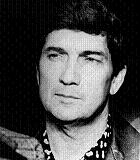 |
Luis Posada Carilles
Then and Now |
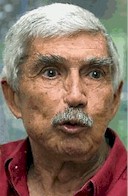 |
"Who were the ones who had the training to murder Kennedy? The ones who had all of the capabilities to carry it out? Who were the expert marksmen?" continues Escalante, pointing out that the case of international terrorist Luis Posada Carriles has to be seen within the historical context of what he calls "the machinery of the Cuban American mafia."
And in the heart of that machinery is Operation 40, created by the CIA on the eve of the failed Bay of Pigs invasion, says the ex-chief of Cuban intelligence, author of The Plot (Ocean Press), about the assassination of the U.S. leader.
FIRST TESTIMONY: JOSE RAUL DE VARONA
"The first news that we have of Operation 40 is a statement made by a mercenary of the Bay of Pigs who was the chief of military intelligence of the invading brigade and whose name was Jose Raul de Varona Gonzalez," says Escalante.
"In his statement this man said the following: in the month of March, 1961, around the seventh, Mr. Vicente Leon arrived at the base in Guatemala at the head of some 53 men saying that he had been sent by the office of Mr. Joaquin Sanjenis, Chief of Civilian Intelligence, with a mission he said was called Operation 40. It was a special group that didn't have anything to do with the brigade and which would go in the rearguard occupying towns and cities. His prime mission was to take over the files of intelligence agencies, public buildings, banks, industries, and capture the heads and leaders in all of the cities and interrogate them. Interrogate them in his own way�.
The individuals who comprised Operation 40 had been selected by Sangenis in Miami and taken to a nearby farm "where they took some courses and were subjected to a lie detector."
Joaquin Sangenis was Chief of Police in the time of President Carlos Prio, recalls Escalante. "I don't know if he was Chief of the Palace Secret Service but he was very close to Carlos Prio. And in 1973 he dies under very strange circumstances. He disappears. In Miami, people learn to their surprise -- without any prior illness and without any homicidal act -- that Sangenis, who wasn't that old in '73, had died unexpectedly. There was no wake. He was buried in a hurry."
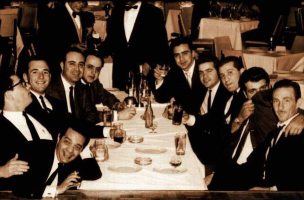 Operation 40 had "in the year '61, 86 employees, of which 37 had been trained as case officers...while in Cuba we probably didn't have one single case officer trained. I didn't finish the course until July of '61 and I was in the first training group."
Operation 40 had "in the year '61, 86 employees, of which 37 had been trained as case officers...while in Cuba we probably didn't have one single case officer trained. I didn't finish the course until July of '61 and I was in the first training group."
A unique photo of Barry & the Boys - meeting in Mexico.
After the failure of the Bay of Pigs invasion, the CIA organizes a Domestic Affairs Division. "For the first time, the CIA is going to work inside of the U.S. because until that moment, it wasn't doing it. It was prohibited.
"And at the head of this division they put Tracy Barnes, who was chief of the CIA operations group which operated against Jacobo Arbenz in Guatemala, and he brought to the same group of officers David Atlee Phillips, David Sanchez Morales and Howard Hunt, and two or three other Americans who just as surely worked on the Guatemala project."
The first CIA project against the Cuban revolution wasn't a landing and assault brigade, remarks the general. "The first CIA project was to create a civil war inside of Cuba. They were thinking of creating political leaders overseas, organizing a series of military cadres overseas who are the ones who will infiltrate Cuba and who will place themselves at the head of this civil war they are planning to carry out. And furthermore parallel to that, to make an intelligence network. All of this falls apart almost as soon as it is born.
"In October 1960, they realize that this project has failed, and that is when Brigade 2506 is formed, when due to the uprising of a group of patriotic military officers in Puerto Barrios in Guatemala and, this was in November, they send the Cuban mercenaries in Brigade 2506 to put down this operation."
DAVID MORALES AND DAVID PHILLIPS
Escalante remembers that in 1959 a "very strong" CIA center existed in Cuba with several case officers based in Havana. Among them two very important figures: David Sanchez Morales, registered as a diplomat with the U.S. embassy, and David Atlee Phillips who was doing business in Cuba since 1957.
"Phillips had a press agency, David Phillips Associates, which had offices on Humbolt St., behind the Rampa theater. We had information from a person who was his personal secretary at the time and he was using the Berlitz Academy, where he would meet with people he wanted to recruit. The Berlitz Academy was not his business, but he had recruited its director and that's why he was using it to train his agents.
"And at that time he recruits Antonio Veciana, Juan Manuel Salvat, Ricardo Morales Navarrete, Isidro Borjas, a person of Mexican origin, to carry out the internal counterrevolution."
Phillips will train illegal cadres while Morales, on his part, directs a group of North Americans who are infiltrated in the Rebel Army: Frank Sturgis, Gerry Hemming, William Morgan.
"When the revolution triumphs these people are officers in the Rebel Army, many of them in the air force because the chief there is Pedro Luis Diaz Lanz, who was the first chief of the rebel air force and who later leaves the country when an assassination attempt against Fidel fails. He will also direct Howard Hunt, who is visiting Cuba in '59 and '60 and who will write a far-fetched chronicle about Havana which is a series of lies. Hunt is a professional liar.
"There was information that at the end of '58, when CIA Inspector General Lyman Kirkpatrick came to tell Batista to leave power, he has an interview with a group of figures. And since this Phillips was passing himself off as a respectable North American businessman, Kirkpatrick has an interview with him. And Phillips explains to him that the situation is very difficult."
In this context, now in the middle of '58, the CIA plans an assassination attempt on Fidel with a North American citizen, Alan Robert Nye, and ex-marine recruited in Fort Lauderdale by agents of the FBI and by the Cuban military intelligence service.
"He was received here in Havana, they put him up at the Comodoro hotel, fortunately they paid his bill and that was how he was later discovered. They sent him to a zone near Bayamo where Fidel was, in a zone called Santa Rita and he was arrested there by the Rebel Army. He had instructions to introduce himself to Fidel as a sympathizer of the Cuban cause and to assassinate him at the first opportunity," recalls Escalante.
The man is arrested on December 12, 1958, by rebel forces and remains in custody until the beginning of 1959. "An officer of the Rebel Army is in charge of the investigation. Knight says that he was lodged at the Comodoro hotel and it turns out that the ones who had paid this gentleman's expenses were none other than Col. Orlando Piedra, the chief of the investigation bureau of the police, and Col. Tabernilla II, the son of the head of the army."
"THE PRINCIPAL ARTISTS"
"These are the principal artists," says the ex-chief of Cuban intelligence. "David Phillips; David Morales; Howard Hunt; a figure who disappeared later and who was head of the CIA until diplomatic relations were broken, James Noel; and several more who were working actively."
When the Domestic Affairs Division is created, the large CIA operations base in Miami was subordinate to the central division of the CIA; "that is to say that the JM/WAVE station, which had 400 officers plus 4,000 Cuban agents, was directed by the main center in Langley.
Fabian Escalante in Havana
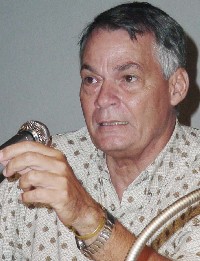 Fabian Escalante was chief of Cuban Security and the Cuban counterespionage services for many years. He loves baseball, painting and is a voracious reader. He retired in the mid 1990s and has authored 4 books.
Fabian Escalante was chief of Cuban Security and the Cuban counterespionage services for many years. He loves baseball, painting and is a voracious reader. He retired in the mid 1990s and has authored 4 books.
"Whom are they going to use? Operation 40. That is to say all of the specialists who are already trained, have gone through the school, have already participated in operations against Cuba...I refer to the group of Felix Rodriguez Mendigutia, Luis Posada Carriles, Orlando Bosch, Virgilio Paz, Alvin Ross, Jose Dionisio Suarez, Antonio Veciana, Ricardo Morales Navarrete, Felipe Rivero, who recently died, the Novo Sampoll brothers, Gaspar "Gasparito" Jimenez Escobedo, Juan Manuel Salvat, Nazario Sargent, Carlos Bringuier, Antonio Cuesta, Eladio del Valle, Herminio Diaz, Pedro Luis Diaz Lanz, Rafael "Chichi" Quintero, Jose Basulto, Paulino Sierra, Bernard Baker, who was a Cuban with a North American name -- he was a guard at the U.S. embassy -- and Eugenio Martinez, alias 'Musculito.'
"And there was the team that brought together all of the North Americans: David Morales; David Phillips; Howard Hunt; Willian Harvey; Frank Sturgis; Gerry Hemming; John Rosselli, who was second head of the Chicago mafia and at that time in '62; Porter Goss, the current head of the CIA, who is in the JM/WAVE as a subordinate of Phillips and Morales."
THE "GRANDMOTHER" OF ALL OPERATIONS
"Operation 40 is the grandmother and great-grandmother of all of the operations that are formed later," continues Escalante.
"The Domestic Affairs Division will have its missions...You have to remember the scandal of the Pentagon papers; a long time later, the Watergate scandal...which are the things that were found out. These people were the plumbers of the division, the men that carried it out."
In 1966 and '67, Felix Rodriguez is in charge of the task force the CIA sends to Bolivia against Ernesto 'Che' Guevara. "He used several names. He is there and he ends up participating directly in the murder of Che. Also there, in another position, is Antonio Veciana. He is there as a bank consultant in La Paz but he runs the center which is coordinating intelligence gathering in the rear guard, working with the Bolivian intelligence services.
"This is very interesting because we are then going to see this whole group in the second large operation they organize, which is advising the secret police of Latin America. We are going to see Felix Rodriguez in 1980 in Argentina, we are going to see Posada in Venezuela..."
POSADA, TORTURER IN CARACAS
Luis Posada Carriles next appears in Venezuela.
"Posada says he arrived in Caracas in 1969, which is not true, he arrived in '67. What is happening is that he is a CIA advisor and it doesn't suit him in his book to talk about that; he says he was recruited in Miami by a chief of DIGEPOL. He's a tremendous storyteller. In reality, Posada is already there in '67 helping DIGEPOL as a CIA advisor.
"After that we are going to see Orlando Bosch's group: Virgilio Paz, Alvin Ross, Dionisio Suarez in Chile after '73. We are going to find 'Mono' Morales Navarrete in Venezuela and Felipe Rivero in Chile...That is to say that this group is going to be spread out in Latin America with actions everywhere."
All of them have devoted themselves, besides the subversive activities, "to drug smuggling, which began when they were training for the Bay of Pigs," says the general.
"The planes came from Miami to Guatemala loaded with weapons, ammunition, personnel, and they returned...even with blood plasma. They were even smuggling blood plasma which Manuel Artime commercialized with the dictatorship of Anastasio Somoza. Drugs started to be included, cocaine."
Phillips was head of Operation 40 from 1960 to 1973..."It is assumed that in '73 Operation 40 was 'discontinued,' as the North Americans say, but that is absolutely not true.
"You have to remember that in '73, the Watergate scandal broke out. Who were the ones who broke into the offices of the Democratic Party? This same group. We are talking about Bernard Baker, Eugenio Martinez, Frank Sturgis, Ferry Hemming, and we learned this from the documents from the Church Commission.
"And after he got out of prison, Eugenio Martinez came to Cuba. Martinez, alias 'Musculito,' was penalized for the Watergate scandal and is in prison for a time. And after he gets out of prison -- it's the Carter period, the period of dialogue, in '78, there is a different international climate -- Eugenio Martinez asks for a contract and one fine day he appears on a boat here...and of course he didn't make any big statements, he didn't say much that we didn't know but he talked about those things, about this Operation 40 group, about what they had done at the Democratic Party headquarters..."
And who are directing the operation against Allende, asks Escalante. "In the first and second part, David Phillips, first as chief of the operations group, and afterwards he moved up to Western Hemisphere division chief of the CIA until 1975. He participates in that and participates in the formation of Operation Condor, which was formed in 1974 when the first meeting of intelligence chiefs of the Southern Cone is held in Santiago, Chile." The veterans of Operation 40 will also participate in Operation Hoja de Parra, which Argentinian intelligence organizes to spy on political emigres throughout Latin America.
Then they appear in Operation Calypso, part of the Nicaraguan contras: "That is to say, when the Argentinian army sends Col. Osvaldo Rivero, first to Miami and then to Honduras, with a group of Argentinian specialists, they fail and the Cubans from Operation 40 have to come; Felix Rodriguez and Luis Posada who in '85 replace the Argentinians and transfer the general headquarters from Tegucigalpa to San Salvador. And the El Aguacate air base which belonged to the Hondurans stops being the main base of air supplies..."
All of the operations carried out, after a certain time, by members of Operation 40 are operations called "autonomous" where the CIA officer who directs the terrorist group -- we're talking about terrorist "action" groups, as they call them -- discusses the objectives of that group, approves it, facilitates all necessary resources "and afterwards reads about the results in the newspaper."
A SOURCE IDENTIFIES POSADA AND OSWALD
About the Kennedy case, Escalante recalls how Cuban intelligence services would receive in the '60s much information from North Americans, from Cubans outside of the country and from Central Americans, about subversive activities.
"By correspondence...Letters would arrive that many times, of course, they would come without a return address or with a fake address. And we started to have information from these figures through this means.
"There is a source who participates in a meeting in Miami in the year '63 in a CIA safe house and who, from what I remember, was related to Veciana, very close to Veciana. This source identifies Luis Posada Carriles, Pedro Luis Diaz Lanz and, I believe, the Novo Sampol brothers...and that same source later recognizes Lee Harvey Oswald as one of the participants.
"The last time we heard about this source was in the '70s when he refers to a meeting with Antonio Veciana and Phillips in Puerto Rico," says Escalante.
"I'm convinced that they wanted to kill Kennedy in different places. Probably that Dallas had better conditions. But I'm under the impression from some very fragmented information I had access to one time, that they wanted to assassinate him in Miami. And I can't exclude, without confirming it, because this information is very relative, that these people had been gathered there for that reason...
"There is another source, who is Maria Lorentz, who relates something similar to this, that is to say that she was in a meeting in Miami, that she saw these people, that she went with them to Dallas, around November 20."
Escalante underlines how a Cuban, Manuel "Manolito" Rodriguez Orcarberro, arrives in Dallas two months before the Kennedy assassination "and he leaves afterwards at full speed."
There he opens an office of Alpha 66, where Oswald will enter at one time, according to the testimony of the assistant police chief of Dallas.
"This Cuban sought asylum in 1960 in the Brazilian embassy together with two known CIA agents. Who were they? Ricardo 'El Mono' Morales Navarrete and Isidro Borgas, a figure of Mexican origin who looks a lot like one of the figures who is with Oswald handing out proclamations supposedly in favor of Cuba in New Orleans -- all of that which was a show put on where Carlos Bringuier goes to challenge them, a fight erupts, and the police arrest all of them..."
And who is the boss of Rodriguez and of Alpha 66? "Antonio Veciana, from Operation 40. That same Veciana whose testimony would lead Gaeton Fonzi to interview Luis Posada in Caracas when he was in prison, due to the similarity between the plan he prepared to assassinate Fidel in Chile and the Kennedy assassination."
Even more: the name that one of the "cameramen" used in Chile is Ramon Medina "which is a pseudonym Posada later used in Ilopango."
There are several sources who place Luis Posada Carriles in Dallas on November 20, 1963, says Escalante.
The ex-chief of Cuban security points to a recent investigation by the Dutchman Wim Dankbaar: "There are elements which even say that Posada was one of the shooters, which cannot be ruled out because Posada is an expert marksman.
[See Posada Carriles' U.S. asylum application re-opens JFK unsolved assassination case]
"Posada who is an expert marksman who graduated from a North American military school. Posada who afterwards becomes, together with Orlando Bosch and all of that gang, one of the leaders of the terrorist groups. Within the mechanism of Operation 40. Posada who since then has always been protected by U.S. authorities, protected by the Cuban American National Foundation, protected by Jorge Mas Canosa."
The assassination of Kennedy could not have been an improvised action in any manner, says Escalante. "If they detoured Kennedy from the avenue where he was traveling to drive around a park, it wasn't for any other reason than to slow down the car to be able to fire at him. Because this famous detour to Dealey Plaza makes no sense. Evidently this makes the vehicle travel at 20 kilometers per hour. And there the fatal shots are fired, from behind and from ahead.
"It had to be a complex operation in which a large group of people participated, because if they shot at him from three shooters' nests which had to have an element of communication as well, to have the means to get out of that place and afterwards to get out of Dallas. We are talking about between 10 and 15 people in the least of cases."
IN CARACAS, THE FBI WAS AWARE OF EVERYTHING
Returning to the subject of the explosion of the Cuban airplane in 1976, Escalante underlines that, in the weeks preceding the attack, Orlando Bosch is in the Dominican Republic, goes to Nicaragua, and then to Caracas with a fake Dominican passport.
"Allegedly invited by Orlando Garcia who if he wasn't head of DISIP at that time was chief of personal security for Carlos Andres Perez. This at the same time that Mono Morales Navarrete had become head of division 54 of DISIP.
"Navarrete arrived when Posada left DISIP, in '74, to organize that front of the Industrial and Commercial Investigations Office. A CIA front which was probably connected with Operation Condor...Why does Posada go over to DISIP? Why does he have disagreements? If he is operations chief of DISIP, he has contact with the U.S. embassy, he's supported by the CIA. Why is he tired of torturing, which is what he did there at DISIP?"
According to reports from the time, at the office of Posada's detectives agency in Caracas they also found plans for the assassination of Orlando Letelier, which occured in Washington on September 21, barely two weeks prior. "Bosch had coordinated the operation in Santiago where he met with General Manuel Contreras, head of DINA." [Chilean secret police -- tr.]
"In '74, Bosch had already gone to Chile with Virgilio Paz, Alvin Ross, Jose Dionisio Suarez to offer himself to Contreras and Pinochet as hit men for Condor...The same Bosch who in 1976 returns to the Dominican Republic, then goes to Nicaragua, meets with the Somoza dictatorship, and then to Venezuela for this operation...Bosch arrives in Venezuela in September and the blowing up of the Cubana airplane was on October 6.
"Where do instructions come from? Where is the plan drawn up? It is drawn up in Caracas. Who are in Caracas? Bosch, Posada and Morales Navarrete. Those are the three figures who are there. This is perfectly documented. As if that weren't enough, Morales Navarrete is an FBI informant, they passed him the bill themselves in '82 for that reason. The FBI was aware of everything they were doing. Probably the CIA gave them the objectives with that cover of autonomous operations. Who was head of the CIA in '76? George Bush Sr. And so...as clear as day! Was Posada still with the CIA?
"In a declassified document from July 1976, the CIA says it broke off with Posada because it had suspicions that he was involved in drug smuggling. That's what it says, that's what it says...when David Phillips gave Veciana a quarter million dollars so he could go to prison for 18 months for a drug trafficking charge," answers the general.
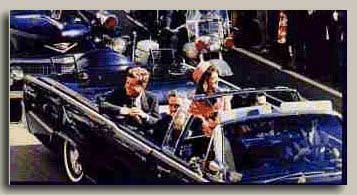
(links embedded by Axis of Logic)
Copyright 2005 by AxisofLogic.com
*Jean-Guy Allard is a Canadian journalist, born in Shawinigan (Quebec) in 1948. He was successively a reporter and news editor for Le Journal de Montreal and Le Journal de Quebec, the two main french-language dailies of both cities, from 1971 to 2000. He then retired in Cuba and has never been so active since, working with Granma International, the weekly edition of the main Cuban newspaper, published in seven languages.
Allard also regularly publishes on cubadebate.cu. He has two sons, one 18 years old and the other one... 13 months. He appreciates living in the big island, far from the snow, the publicity, the Canadian media and the Canadian income tax system. No bills in the door every morning, plenty of rumba y cha-cha, a good cigar from time to time on the beach under a palm tree, and the Cuban Revolution that gives him the opportunity to live a page of history. He doesn't really care if George and Jeb Bush nor Otto Reich do not agree.
Read more about the related, ongoing investigation by JFK Assassination Expert, Wim Dankbaar (Netherlands).

